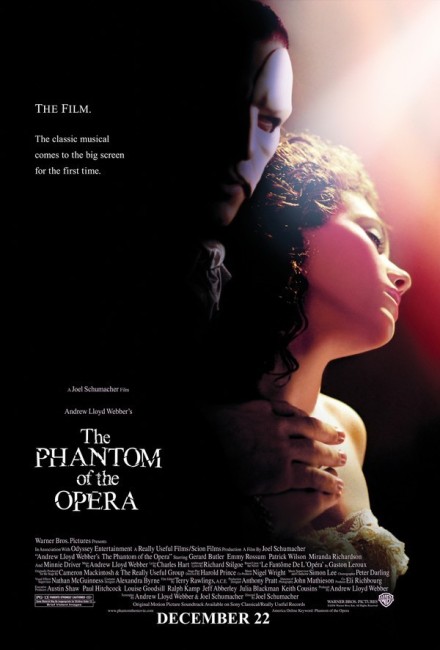Crew
Director – Joel Schumacher, Screenplay – Joel Schumacher & Andrew Lloyd Webber, Based on the Stage Musical by Andrew Lloyd Webber, Based on the Novel by Gaston Leroux, Producer/Music – Andrew Lloyd Webber, Photography – John Mathieson, Lyrics – Charles Hart, Additional Lyrics – Richard Silgoe, Visual Effects Supervisor – Nathan McGuinness, Visual Effects – Asylum (Supervisor – David V. Jones), Models – Cinesite (Europe) Ltd (Supervisor – Jose Grannell), Special Effects Supervisor – Peter Hutchinson, Makeup Effects – Animated Extras, Production Design – Anthony Pratt. Production Company – Really Useful Films/Scion Films..
Cast
Emmy Rossum (Christina Daae), Gerard Butler (The Phantom), Patrick Wilson (Viscomte Raoul de Chagny), Minnie Driver (Carlotta), Miranda Richardson (Madame Giry), Simon Callow (Andre), Ciaran Hinds (Firmin), Jennifer Ellison (Meg Giry), Kevin McNally (Buquet)
Plot
In 1919, an auction held at the abandoned Popular Opera in Paris brings back memories for one aging attendee. He remembers back to 1870 when the Opera was at its height, just having been taken over by the junk merchants Firmin and Andre. The two dismissed the reports of a mysterious Phantom that lurked beneath the Opera. The Phantom then arranged an accident that put the self-absorbed diva Carlotta out of action. The chorus girl Christine Daae was quickly brought in to take Carlotta’s place and proved a smash success in the part. The masked Phantom then appeared to Christine, sweeping her away to his lair in the catacombs beneath the opera house. At the same time, Christine was also romantically drawn to the handsome Viscomte Raoul de Chagny. This incurred the wrath of The Phantom, who had fallen for Christine, causing him to erupt in revenge.
I have heard in mention several times the apocryphal story of someone who was standing in a record store during the mid-1970s and overheard two teenage girls say in amazement “Gee, I didn’t know Paul McCartney was in another band before Wings.” There are probably various other variations on such a story, all of which are used to cite as examples of how today’s youth live in ignorance of what has gone before them. As an historian of horror film, I have had several similar occasions where people have come up to me and made the comment: “Gee, I didn’t know there had been a film made of The Phantom of the Opera before the musical came out.” I cite this because it shows two things – firstly, just how prevalent the musical Phantom of the Opera phenomenon has become and, secondly, how it has altered people’s perceptions as to what the original story was about.
To respond to such questions, one puts their all-important air of being a deacon of obscure trivia on and says “Well, actually there have been no less than seven different films made out of The Phantom of the Opera before the musical came out.” This usually produces a look of amazement and one can then go for the coup de grace and tell the person how, rather than the florid romance that it has been made into by the musical, that these other films tell The Phantom of the Opera as a horror story, while the original book that all of these are based on was intended as a Gothic thriller.
The Phantom of the Opera musical is a case of a phenomenon having changed and shaped a public perception of a story in an entirely different way to the one it was originally intended. Prior to 1986, when the musical phenomenon began, The Phantom of the Opera was a character that lived in the pantheon of Universal Famous Monsters where the original role was celebrated for Lon Chaney’s performance and its triumph of grotesque makeup; after the musical, the story was claimed by the same middle-aged crowds that regard My Fair Lady (1964) and The Sound of Music (1965) as the pinnacles of cinematic art, or by lovers of melancholy romantic fantasy along the lines of tv’s Beauty and the Beast (1987-90).
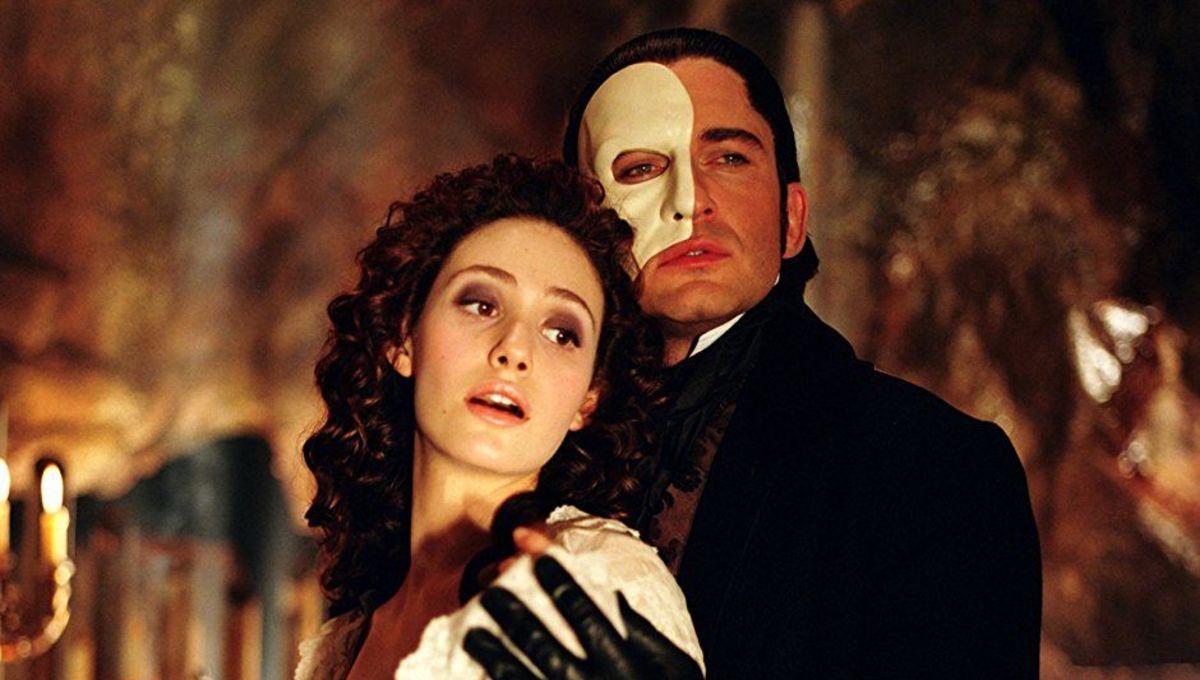
The Phantom of the Opera (1909) was originally written by French mystery writer Gaston Leroux. The first and the very best of the film adaptations came with the silent The Phantom of the Opera (1925) starring the great Lon Chaney [Sr], an actor who made the virtue out of grotesque disguises. The Chaney Phantom of the Opera still stands as the greatest version of the story, made with a Gothic flair that no other adaptation has ever managed to recapture. It was subsequently followed by the pallid Universal colour remake Phantom of the Opera (1943) starring Claude Rains; the Hammer version The Phantom of the Opera (1962) starring Michael Gough; Phantom of the Opera (1983), a tv mini-series with Maximilian Schell and Jane Seymour; the slasher movie version The Phantom of the Opera (1989) with Robert Englund, which involved time travel and The Phantom selling his soul to The Devil; a reasonable tv mini-series version The Phantom of the Opera (1990) featuring Charles Dance; and Italian horror director Dario Argento’s take The Phantom of the Opera (1998) starring Julian Sands. That does not count odd distaff versions such as the musical parody of The Phantom of the Paradise (1974); a pornographic version Phantom (1998); Angel of Music (2008) about a modern reporter conducting an investigation into the truth of the story; Phantom of the Theatre (2016), a Chinese version that conducts some radically different takes on the story; modernisations like The Phantom of Hollywood (tv movie, 1974), The Phantom of the Ritz (1988), Phantom of the Mall: Eric’s Revenge (1989) and a Disney Channel children’s tv movie The Phantom of the Megaplex (2000), which had the Phantom haunting respectively a movie studio, a movie theatre, a mall and a cinema multiplex, as well as the low-budget The Phantom of the Opera (2014) where the Phantom’s spirit is disturbed by a reality tv crew; and the story even being given an uncredited relocation to another planet in the Doctor Who episode The Caves of Androzani (1984).
However, it was the 1986 musical by Andrew Lloyd Webber, the talent behind other huge Broadway successes such as Joseph and His Amazing Technicolor Dreamcoat (1968), Jesus Christ Superstar (1972), Evita (1976), Cats (1981), Starlight Express (1984) and Sunset Boulevard (1993), that has eclipsed modern memories of these other versions of the story. The musical was a mass phenomenon. It has had an unbroken 23-year run on Broadway, which still continues to this date, making it the most successful Broadway musical of all time. It has produced numerous merchandising spinoffs, including widely sold T-shirts, albums, books and the turning of The Phantom’s white half-mask into an iconic symbol that was sold on badges and as Halloween store novelty items. The musical even managed to make star Michael Crawford, who before that was the forgotten comedy actor from tv’s Some Mothers Do ‘Ave ‘Em (1973-8), into an unlikely romantic idol at the age of 44 and well on into his 50s. I must admit to not being a big fan of the musical phenomenon. Aside from the title track with its wonderfully shivery Gothic organ shifts, the soundtrack did little for me. I guess mostly what I disliked was seeing a wonderful story having been bled of its horror elements and made into a weepy romance.
This is the film version of the musical. The Phantom of the Opera film was long planned – and, in fact, was ready to go around 1990, starring Michael Crawford and Sarah Brightman from the musical, only to fall apart when Andrew Lloyd Webber and Sarah Brightman divorced. The film’s sad fate is to be lumbered with probably the worst director in the world – Joel Schumacher. Joel Schumacher had nevertheless been selected for the job from the beginning by Andrew Lloyd Webber, who co-financed the film version, apparently because Lloyd Webber was impressed by Schumacher’s film The Lost Boys (1987), which probably says all there is to about Andrew Lloyd Webber’s credibility when it comes to selecting directors.
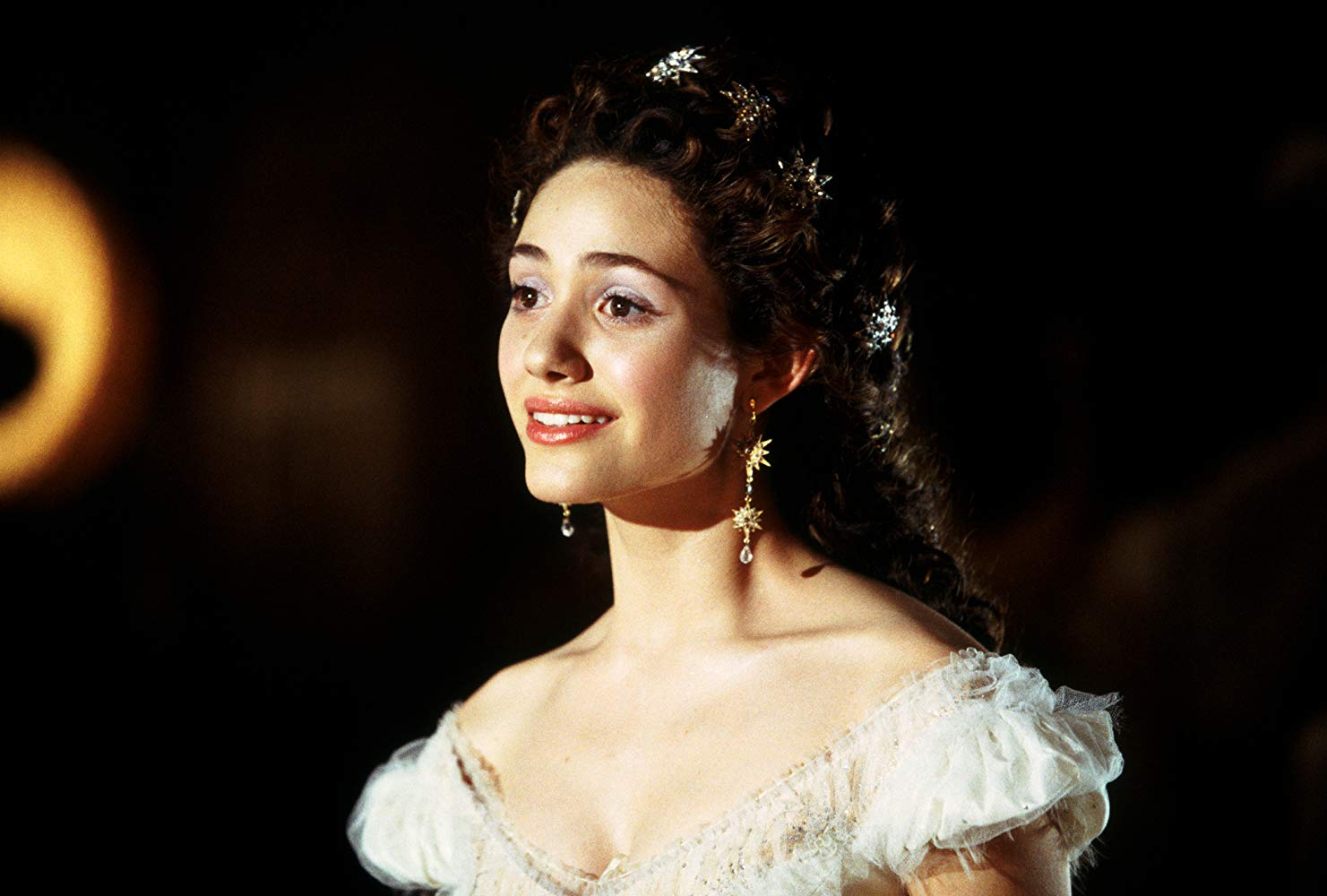
Let me count the ways that I detest Joel Schumacher. Probably No.1 among these would be Batman & Robin (1997), which is almost certainly the worst A-budget film made in the entirety of the 1990s, and to a lesser extent Batman Forever (1995), both of which turned Tim Burton’s magnificent and moody Batman films into infantile big-budget camp extravaganzas. No. 2 might be that vile rant of American redneck contempt called Falling Down (1993). No. 3 might be that Joel Schumacher has never had an original thought in his life, let alone had anything to say that went beyond the depth of surface prettification. Schumacher was a former window dresser who joined the film industry as a costume designer and then branched out to write the scripts for Car Wash (1976), The Wiz (1978) – another leaden musical disaster, and D.C. Cab (1983), before making his directorial debut with the enjoyable The Incredible Shrinking Woman (1981). Schumacher has passed through a number of films including St Elmo’s Fire (1985), The Lost Boys, Flatliners (1990), Dying Young (1991), Falling Down, The Client (1994), Batman Forever, A Time to Kill (1996), Batman & Robin, 8MM (1999), Flawless (1999), Tigerland (2000), Bad Company (2002), Phone Booth (2002), Veronica Guerin (2003) and subsequent to this The Number 23 (2007), Town Creek (2009) and Twelve (2010).
What is so detestable about Joel Schumacher is that he is a director purely of stylistics and almost entirely lacking in anything of substance. Schumacher swaps and changes directorial styles exactly like they were storefront window dressings – be it the MTV flash of The Lost Boys, appropriating Ridley Scott in Flatliners, Lars von Trier in Tigerland, David Fincher in 8MM, or turning the Batman franchise into a giant campy variant on the 1960s Batman tv series. I was interested to read that Joel Schumacher is also one of the few openly Out gay directors in Hollywood. That, in a way, is Schumacher’s problem – his films read like a stereotypical gay man’s fascination with fabulous surroundings, pretty people and kitsch affectation (the famous Batsuit with nipples!) at the expense of anything else. It is, for example, impossible to detect in Joel Schumacher’s films any personal interest in the thematic material – the stylistic affectations are the sum total of the film, everything else is provided by the screenwriters and Schumacher seems to lack any ability to discern whether his scripts are good (Phone Booth) or duds (the Batman films), outrightly preposterous (The Number 23) or even politically and racially offensive (Falling Down).
In this sense, Joel Schumacher is probably perfectly aligned with Andrew Lloyd Webber – the Phantom of the Opera stage musical was after all all about stylistic affect and a spectacular stagy array of weepy Gothic romanticism. As such, the Phantom of the Opera film exists more as a series of scenographic poses that it ever does a dramatic entity. It is certainly a triumph of cinematography, production and costume design. Schumacher whips us through cluttered backstages filled with extras seemingly out of some Dickensian tale, snowy graveyards and rooftops filled with statues of angels in every conceivable direction, bawdy comedia dell’arte pantomimes. The camera’s eye is constantly filled with horse-drawn carriages, artfully dropped roses, caped figures lurking in the shadows and clever dissolves between black-and-white and colour. As a 143 minute long music video for the musical, The Phantom of the Opera is gorgeous; but as a dramatic film, it feels unmoving.
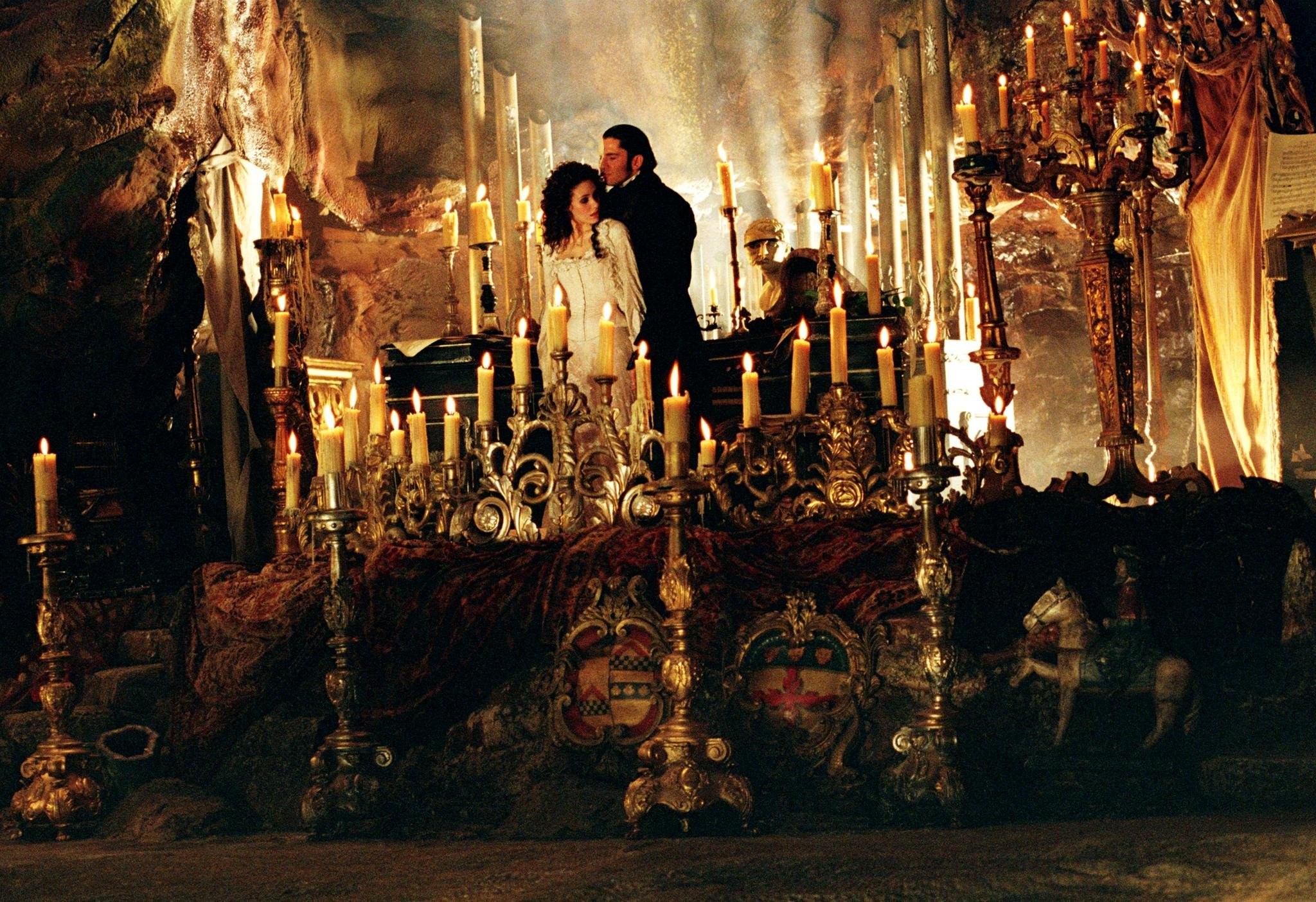
Even when it comes to the dramatic poses, Joel Schumacher mismanages them. Two of the three most famous scenes in any version of The Phantom of the Opera – The Phantom’s appearance at the masque and the unmasking – are handled with an almost entire lack of effect (the third being the falling of the chandelier, which comes off adequately). The Phantom turns up at the masque but is outfitted in merely a mask and red tunic. This fails almost entirely in dramatic effect, despite this film’s making a virtue of being an extravagant costume ball, and especially when compared to Lon Chaney’s resplendent appearance as Edgar Allan Poe’s Red Death in the 1925 version. Ditto the unmasking of The Phantom. In the 1925 version, this became one of the classic moments of screen horror. Here, despite Joel Schumacher staging no less than two unmaskings, it is lacking in any effect at all. Part of the problem is that the mask has been designed in such a way as to highlight Gerard Butler’s handsome looks to the max and when stripped off, what is shown – a reddened face and a malformed eye – is not particularly scary.
Other aspects of the story are given half-hearted treatment. Certainly, this version does manage to be one of the few screen treatments of the story, aside from the 1925 film, that returns to the climactic scenes of the Gaston Leroux novel as the rescuers venture down into the catacombs beneath the opera house, which The Phantom has filled with traps. There is a cool scene with The Phantom trapping Raoul de Chagny in a hall of mirrors, but this is too brief to be effective, and another cursory one where de Chagny is trapped underwater beneath a grille, but it is clear that Joel Schumacher is not interested in exploring the thriller aspect of the story.
Even scenes that were highlights of the musical seem mismanaged by Schumacher – the scene where The Phantom sweeps Christine away underground and takes her by boat to his lair should have been a romantic highlight of the film, but this seems as though it is conducted on cramped, cut-price sets. With typical Schumacher-esque flair for cool design effect and absolutely no thought going into whether it makes sense or not, the arrival at The Phantom’s lair is heralded by the ludicrous sight of a series of candelabra with lit candles popping up from under the water.
Scottish actor Gerard Butler, who had not yet appeared as King Leonidas in 300 (2007) and become an A-list name, was an unusual choice as The Phantom at the time – one suspects it was something to do with Joel Schumacher trying to prove the dubious claim he is afforded of having discovered (or at least given breakthroughs to) future stars like Colin Farrell, Brad Renfro and Matthew McConaughey. Unfortunately, Schumacher gives us a Phantom that exists more as a series of poses – outlined in shadows, running with cape flapping, the artfully silhouetted half-mask – than he ever does as a character.
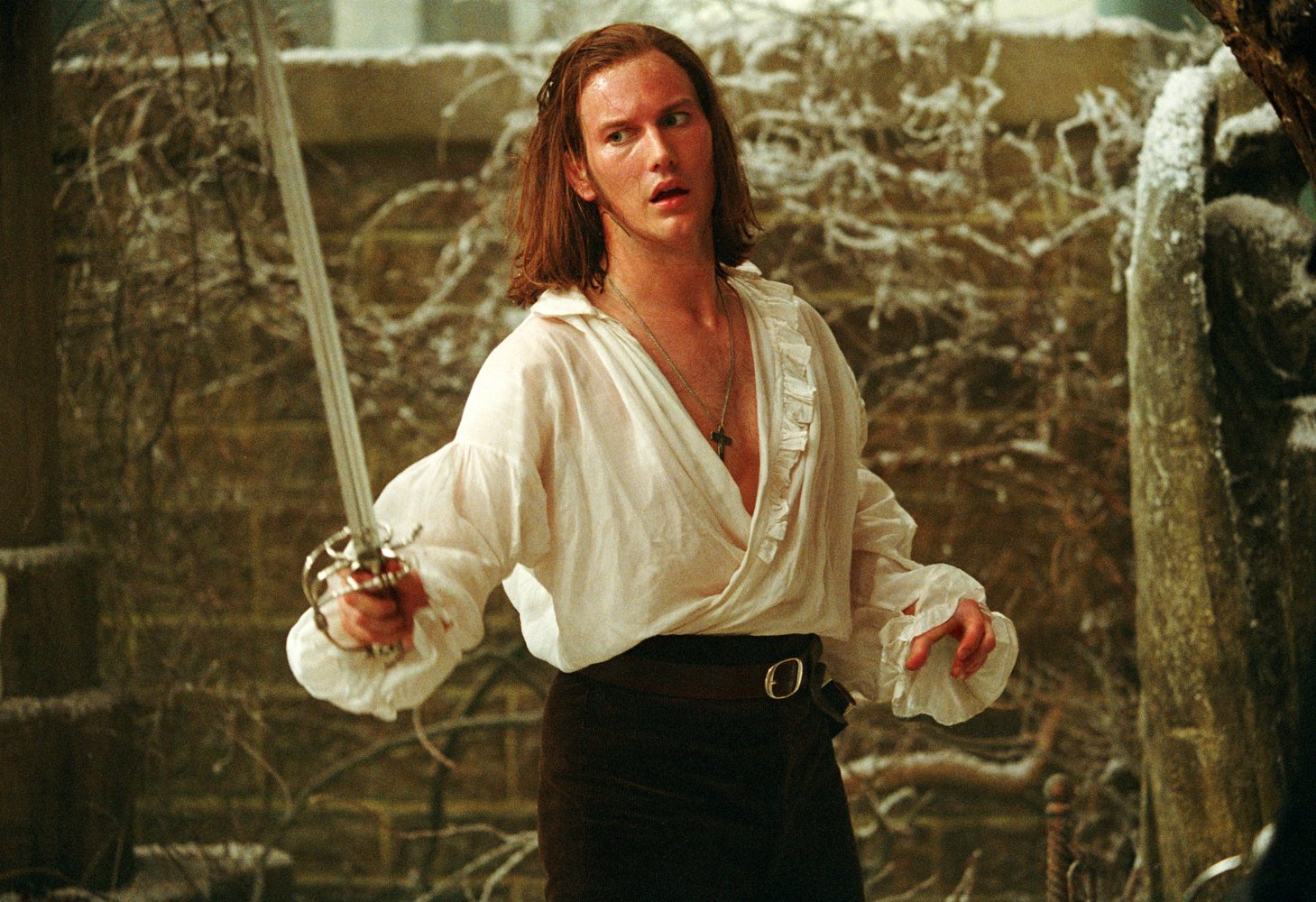
This is a Phantom remarkably lacking in any presence – almost even in any threat or brooding romantic quality. For a stage show that gained its success by turning The Phantom of the Opera into a moody romance, there is never any point in the film when we see into the Phantom’s soul. Schumacher does give us a flashback origin story of sorts – but this has been stolen from The Elephant Man (1980). If anything, The Phantom comes across as wimpy. At one point, he is beaten by the scrawny Patrick Wilson in a sword duel and reduced to cowering on the snowy ground, which is a sad stripping of the dark mystery that such a wonderfully brooding character has.
Far more successful is the film’s version of Christine Daae. Joel Schumacher and Andrew Lloyd Webber cast eighteen-year-old Emmy Rossum, who had previously appeared as the young Audrey Hepburn in The Audrey Hepburn Story (tv movie, 2000) and in various films like Mystic River (2003) and The Day After Tomorrow (2004). Emmy Rossum has the same beatifically fresh-faced innocence that Sarah Brightman did in the stage show – and even looks like Brightman. She is perfect in the part and one expects her to go onto better things. The scene-stealer of the film is Minnie Driver, who gives a thoroughly splendid showing in the role of the diva Carlotta. Although, it may say something about what a misdirected production that the film is when the role of Carlotta – which is deliberately meant to be that of a bad actress – ends up upstaging the film’s Phantom.
The other disappointment that comes in the casting is Patrick Wilson. I was very impressed with Patrick Wilson in tv’s Angels of America (2003), where he was perfect as a milquetoast Mormon just starting to come out of the closet, and as the paedophile in the subsequent Hard Candy (2005), as well as subsequent high-profile roles. Here he seems miscast as the handsome romantic lead. For one, there is the absurd sight of Wilson trying to play a long-haired romantic hero despite having a receding foreline. The role of Raoul de Chagny should be inhabited by someone of impossibly good boyish looks or else of a strapping heroism – indeed, Gerard Butler would have been perfectly cast here – but Patrick Wilson seems to disappear into a blandness and become buried by the role.
(Nominee for Best Actress (Emmy Rossum), Best Supporting Actress (Minnie Driver), Best Cinematography and Best Production Design at this site’s Best of 2004 Awards).
Trailer here

